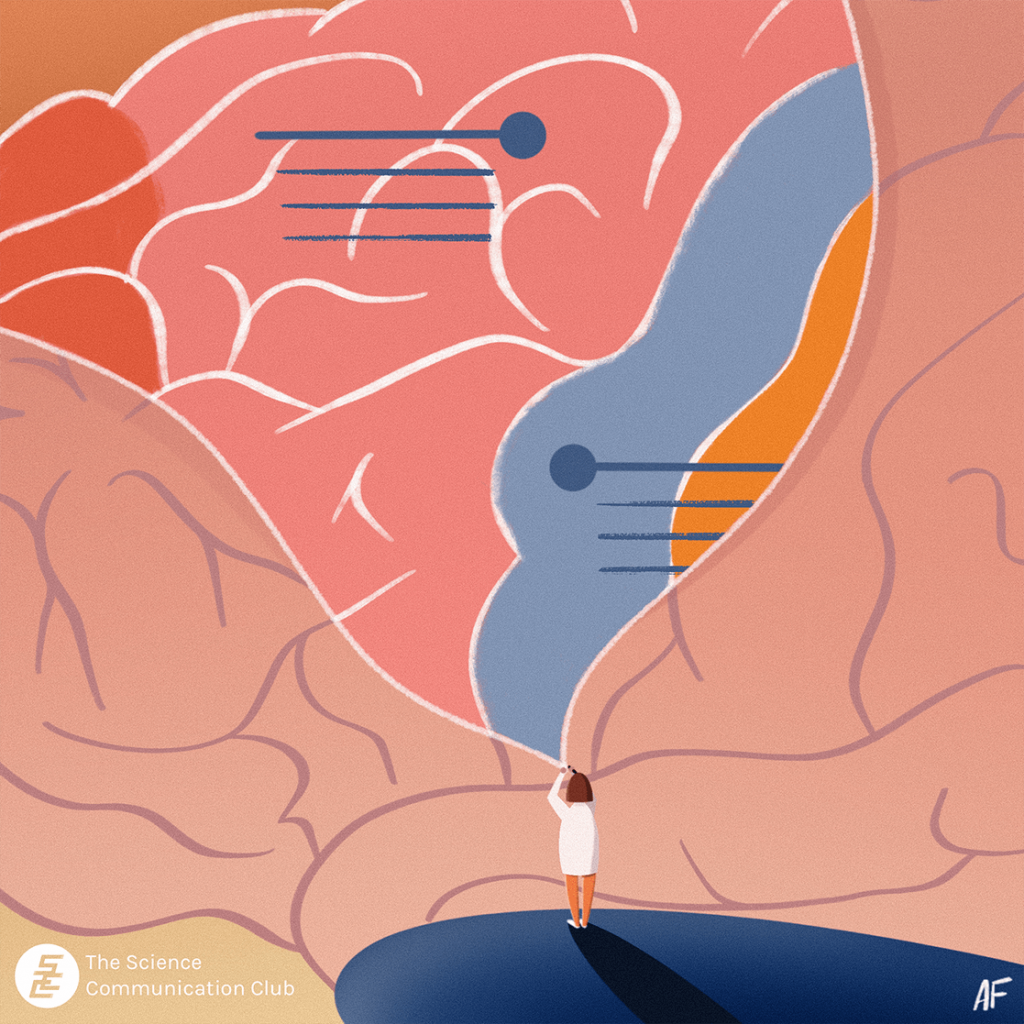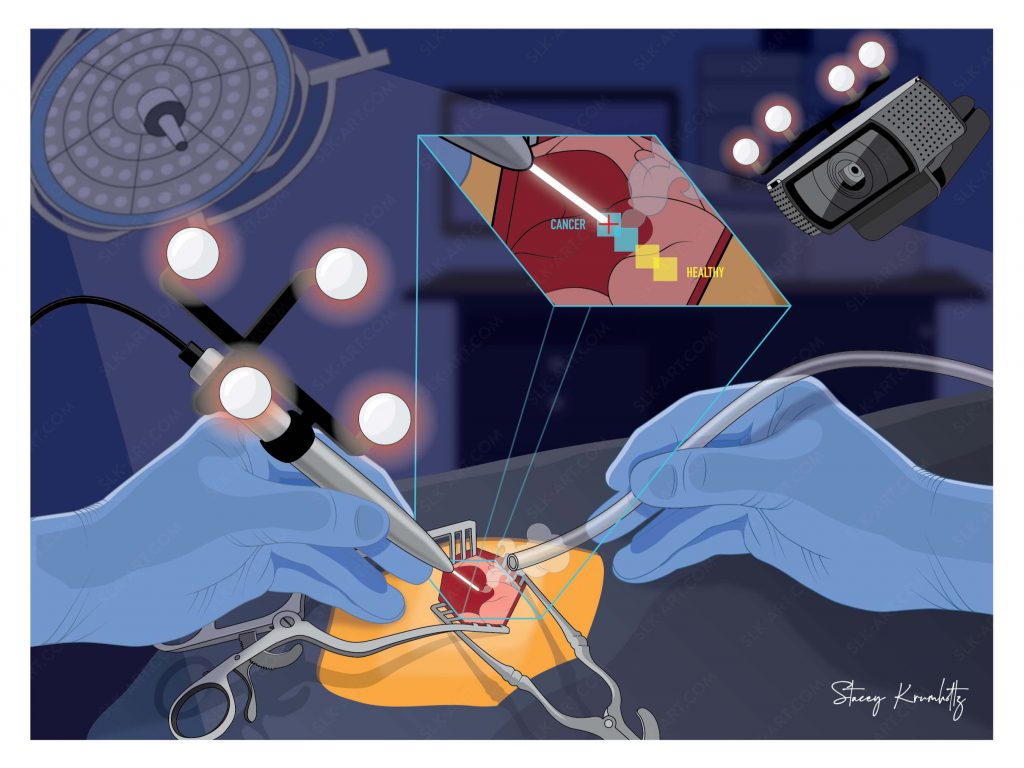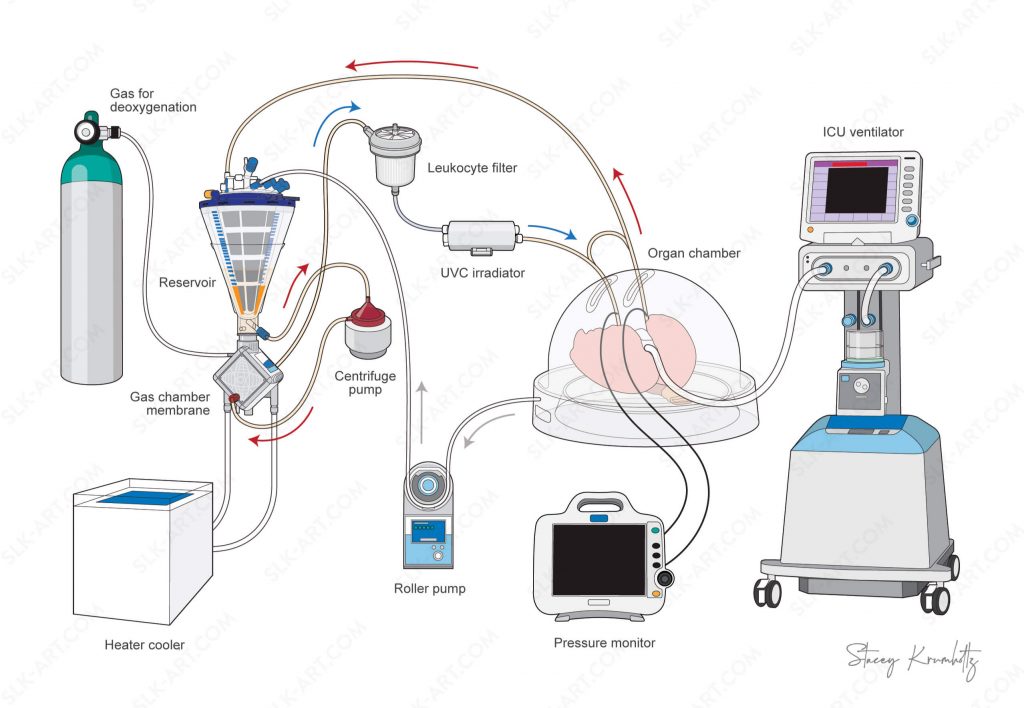
Written by Ersi Zabzuni
Illustrated by Andreea Furdui
As a brilliant Medical Illustrator at the Hospital for Sick Children (SickKids) and the University of Toronto, Stacey Krumholtz has combined her passion for art with her background in science to produce creative and informative graphics. She predominantly works with Dr. James Rutka at SickKids, translating important information regarding pediatric brain tumors into illustrations and animations. Stacey’s talent and enjoyment in the field of Medical Illustrations has led to her work being published in various journals including Chemical Science and the Chinese Neurosurgical Journal. We had the pleasure of interviewing Stacey, who shared with us valuable insights into her journey in Medical Communications and helpful advice on navigating the field.
Science Communication Club (SCC): What drew you towards medical illustration?
Stacey: I realized quickly when I got into BMC (Biomedical Communications) that I thought my story was unique. I noticed everyone had the same story, which is that we all were good at science and were also really talented when it came to artistic things like drawing and communicating. For a long time, I was going to stick with the safe path and be a doctor or researcher, not that those are safe paths, but better known. As I got closer to that being the reality, I felt like I was going to be missing this whole creative aspect of who I was. I thought: you spend so much of your life working, so why would I not be incorporating this skill that I have in something I love to do into a career? I started looking into animation and illustration programs. I already had done my undergrad, and I wondered if I wanted to start over again and get a second undergrad degree. I spoke to some people and that’s where I met a man by the name of John Parker at Sheridan College. He pointed me to the BMC program at UofT and it was a perfect fit for me. I completed half a year at Sheridan to help prepare my portfolio to apply to BMC, as a portfolio is mandatory. I applied and luckily got in through my first application and then took the program.
SCC: Did you feel it was difficult making this switch? You mentioned that you considered research, medical school and dentistry.
Stacey: It was not hard to get where I ended up, as it was a long road; I completed my undergraduate degree in 2008 and graduated from BMC in 2015. There were a lot of years in the middle where I was trying to figure out what I was doing with my life and my career. I also didn’t want to start down a road that I was going to regret. People make choices based on the pressure of time and I wanted to avoid doing this—I wanted to stick with my career path. I ended up bartending for a while and I also took some time off to travel, so my switch into BMC was not hard as it was a longer road.

SCC: That’s a very interesting journey. Was the BMC program more arts focused, or did it incorporate a vast amount of science—such as physiology and mechanisms?
Stacey: It was a mix of both. The first year is academically inclined with heavy science and you have to have certain core courses and a basic knowledge in different areas of science. You also won’t be accepted if your grades aren’t at a certain level and if you haven’t taken enough breadth of knowledge courses that will prevent you from feeling lost in the program. My class only had 15 people in it: two students already held PhDs, several of them held Master’s degrees, and I just had an undergraduate degree. Everyone was very bright and had science backgrounds, which I thought was necessary. The courses were intense, for example we had an anatomy class with first-year medical students. We completed full cadaver dissections and attended the anatomy lectures. During the second year, you get a thesis or Master’s project and you have a year to complete that. You get to figure out your interests; some people liked animation; some people enjoyed other media. I would say second year is more about applying your skills and vision for your art.
SCC: What are some challenges that you think aspiring medical illustrators should be aware of?
Stacey: Things are rapidly evolving and the skill-set required to be a medical illustrator and get into the program is changing so quickly. When I did the program, very few people had any experience in Photoshop and Illustrator, and we had to learn this in our first year. There was one woman in my class that was incredibly talented; she was the only person in our class that had ever worked on a tablet. Digital art was very foreign to a lot of us, however, currently, that’s how I work. I might do some sketches with pen and paper, but realistically the work is digital and most people applying now have extensive experience in these programs. I think it’s challenging to compete these days if you are coming from where I came from, which is a fully fine arts background of just having drawn and painted. I also don’t know what the application rates are, but it’s becoming more well known as a program. I think just having a larger applicant pool would also be challenging.
With COVID, it’s like we’re acutely aware now of how important science communication is and how it’s severely lacking, like the amount of misinformation out there and that the general public doesn’t have a basic understanding of science knowledge. Having more people working in this field could really make a difference in science communication on a global scale.
SCC: Could you describe your position as a medical illustrator at SickKids?
Stacey: I don’t work in the hospital, I’m in the research tower just behind it (the Peter Gilgan Center for Research and Learning). I’ve been working from home for the past five years, so the pandemic working conditions weren’t new to me. I used to go in once a week and that once a week meeting is now a Zoom call. I work for James Rutka who is a pediatric neurosurgeon at SickKids and he is also the head of the Brain Tumor Research Center [(BTRC)] there. He wears a bunch of hats and wherever he works, I work. He is also the chair at UofT at the Department of Surgery, so I worked there as well. They hire several summer students every year, typically in research positions. Christian Smith, who’s the operations manager for the BTRC, saw an opportunity to hire someone different. One year he decided that they typically hired these research students, but he knew about BMC, and he thought hiring an illustrator would be beneficial. That student was me and I did my research project with them as well. They offered me a full-time job when my project was completed—I got lucky and it’s a great place to work.

SCC: Just to follow up on that, what kind of illustration projects do you do with Dr. Rutka and then with the faculty at UofT as well?
Stacey: At SickKids, it’s mostly research focused. There are several principal investigators, I mostly worked for Dr. Rutka, but there are several other ones at the BTRC that have access to me as well. There are also PhD and Master’s students doing different projects, which is all brain tumor research focused. The goal is always to get your work published in a peer-reviewed journal and in this process, some sort of illustration is typically required. We do a lot of cell biology, genetics, and that sort of thing.
It can be related to protein interactions, infographic-type things, things more at the cellular level. Occasionally we are asked to write book chapters for textbooks in the field and those also require illustrations. At UofT, I do some surgical illustrations and graphic design work for them as well, as they don’t have anyone in this position.
SCC: How do you think your work impacts both patients and the general public?
Stacey: I’m in the academic side of things, so I don’t know how much of my work reaches the patient level of things. I am stuck in an academic sphere, which I love because I love research. It would be great to have a broader impact and have things reach patients. We are revamping our website to get work we are doing more public-facing. If you were a patient or parents of a child with a brain tumor you would probably go to the SickKids website. I have had some stuff published in textbooks and it’s cool to think someone will be studying off my illustrations.
SCC: What are three aspects you enjoy most about your career?
Stacey: I love the variety of work I get to do. There isn’t really a set job at the end of the road after taking the BMC program. I know colleagues that are working at museums, the National Institute of Health, private companies—there is a broad spectrum of places you can end up. Where I am at (with Dr. Rutka), I work at the Journal of Neurosurgery doing illustrations for them. SickKids is more research focused, and at UofT I complete graphic designs. I get a large breadth of work, which keeps me busy and prevents me from getting bored. I also love the flexibility of working independently and from home. I do love collaborating with clients and the researchers/doctors that I work with. The work that I do is my own, as much as it is owned by SickKids, but I get to say I made the finished product. Since everything is digital, my world did not change since COVID happened—I just continued to do what I always did. The third aspect I really enjoy is collaborating with the people I work with. I am a permanent fixture in the lab, there are PhD and Master’s students that come from all over the world: Japan, Ukraine, the UK, Australia. I meet all these people and learn their story and that they are genius-level smart.

SCC: Can you highlight the most interesting project you have worked on (in your opinion)?
Stacey: Last summer I worked with a researcher at Princess Margaret Hospital. We typically end up publishing in similar journals, but we were published in Chemical Science this time. It was an area of work I never thought I would get published in, and my work was on the back cover of the publication. I am fascinated by the science: they were developing a method of sampling brain tumors live using Mass Spectroscopy. They could tell what type of tumor it is as it’s happening, which has not been done before. I got to draw the process and highlight their work and Chemical Science liked it enough that it was published on the back cover.
SCC: Do you have any advice for people that are interested in Medical Illustration?
Stacey: People that run the program are amazing—the faculty is small and very tight knit. I attended a UofT showcase of different Master’s programs and I spoke with Shelly Wall, who is one of the faculty of the program. They asked me to bring in my portfolio and said they would give me feedback and how I could strengthen it. Take advantage of what these individuals have to offer: they are very helpful and would like to help you improve. Being open to bettering yourself and working on your skills is important. You can also take some classes to help you make your portfolio the best it can be.
You can explore more of Stacey’s work by visiting her social media platforms or website found below:
Instagram: Krumholtz_art
Twitter: @Krumholtz
Website: http://www.slk-art.com/